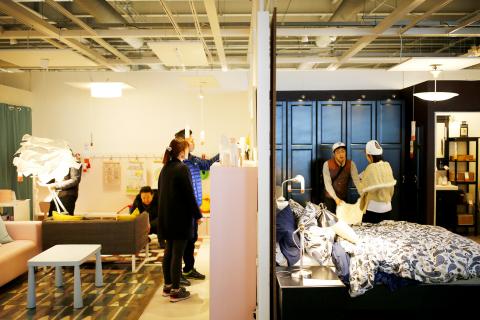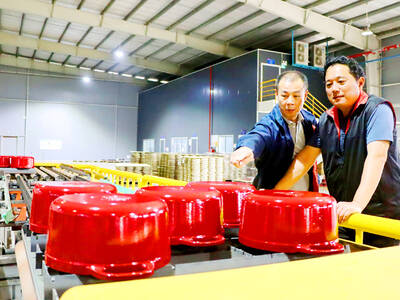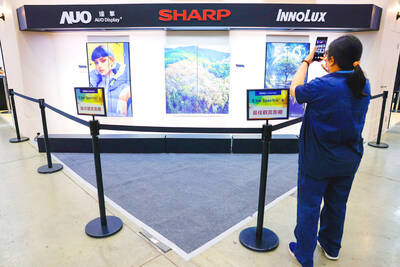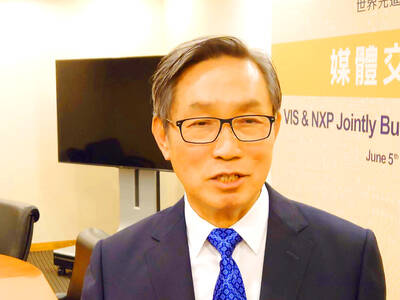IKEA was onto something when it opened its first South Korean store, its largest anywhere, in late 2014.
Home furnishing chains are a bright spot in a sluggish South Korean economy, tapping demand from the rising share of people who are living alone and spending more to make their dwellings attractive and comfortable.
Local market leader Hanssem Co Ltd, with sales of more than US$1 billion in 2014, saw a 31 percent increase in revenue for the first nine months of last year and a doubling in its share price for the year as it opened 27 of its larger stores in 2014 and last year. Shinsegae Co Ltd’s Jaju chain opened 10 stores last year, bringing its total to 149.

Photo: Reuters
Swedish giant IKEA, whose single store on the outskirts of Seoul generated US$260 million in its first year, expects to spend 1.2 trillion won (US$997 million) to open five more South Korea stores by 2020 — one more than earlier planned.
South Korea is following a path seen in the US and Japan, with people spending more on home decoration as per-capita GDP rises, analysts say.
“Four or five years ago, people thought home decorating was only for rich people,” said Ock Soo, 32, who founded Webzine Rooomers and conducts decorating classes attended mostly by singles.
“Now home decoration is for everyone, as more people are living alone and for longer periods,” she said.
Home decorating shows known as “jipbang” have been proliferating on TV, including “Old House, New House” and “My Room’s Dignity,” both of which debuted in December last year.
A fast-graying South Korean population and heavy household debt, at 1.7 times annual disposable income, make property investment less attractive, prompting homeowners and renters to spend instead on making their existing dwellings more liveable. South Korea’s working-age population is set to peak this year.
“People no longer see houses as an investment, but as an object of utilization,” said Lee Gwang-soo, an analyst at Mirae Asset Securities. “People start decorating their homes because they now have to ‘live’ in them.”
Last year, South Koreans spent 12 trillion won on home interior decoration, including floors, walls, doors, kitchen and bathroom fixtures and labor, up from about 9 trillion won in 2014 and forecast to grow to 27 trillion won by next year, according to Mirae Asset Securities.
Those figures exclude furniture and off-the-shelf items, which make up the bulk of sales at retailers like IKEA and H&M Hennes & Mauritz AB’s H&M Home, and came despite economic growth that slowed to 2.6 percent last year, from 3.3 percent.
Korea Investment & Securities estimates the domestic furniture market is worth about 8 trillion won, with kitchen items counting for another 3 trillion to 4 trillion won.
The share of single-person households in the country rose to an estimated 27 percent last year from 20 percent in 2005, according to Statistics Korea, and is forecast to reach 31 percent in 2025 as younger people delay getting married and having children in the fastest-ageing industrialized country.
People living on their own spend a larger share of their incomes on consumption, including decoration.

TAKING STOCK: A Taiwanese cookware firm in Vietnam urged customers to assess inventory or place orders early so shipments can reach the US while tariffs are paused Taiwanese businesses in Vietnam are exploring alternatives after the White House imposed a 46 percent import duty on Vietnamese goods, following US President Donald Trump’s announcement of “reciprocal” tariffs on the US’ trading partners. Lo Shih-liang (羅世良), chairman of Brico Industry Co (裕茂工業), a Taiwanese company that manufactures cast iron cookware and stove components in Vietnam, said that more than 40 percent of his business was tied to the US market, describing the constant US policy shifts as an emotional roller coaster. “I work during the day and stay up all night watching the news. I’ve been following US news until 3am

UNCERTAINTY: Innolux activated a stringent supply chain management mechanism, as it did during the COVID-19 pandemic, to ensure optimal inventory levels for customers Flat-panel display makers AUO Corp (友達) and Innolux Corp (群創) yesterday said that about 12 to 20 percent of their display business is at risk of potential US tariffs and that they would relocate production or shipment destinations to mitigate the levies’ effects. US tariffs would have a direct impact of US$200 million on AUO’s revenue, company chairman Paul Peng (彭雙浪) told reporters on the sidelines of the Touch Taiwan trade show in Taipei yesterday. That would make up about 12 percent of the company’s overall revenue. To cope with the tariff uncertainty, AUO plans to allocate its production to manufacturing facilities in

Six years ago, LVMH’s billionaire CEO Bernard Arnault and US President Donald Trump cut the blue ribbon on a factory in rural Texas that would make designer handbags for Louis Vuitton, one of the world’s best-known luxury brands. However, since the high-profile opening, the factory has faced a host of problems limiting production, 11 former Louis Vuitton employees said. The site has consistently ranked among the worst-performing for Louis Vuitton globally, “significantly” underperforming other facilities, said three former Louis Vuitton workers and a senior industry source, who cited internal rankings shared with staff. The plant’s problems — which have not

TARIFF CONCERNS: The chipmaker cited global uncertainty from US tariffs and a weakening economic outlook, but said its Singapore expansion remains on track Vanguard International Semiconductor Corp (世界先進), a foundry service provider specializing in producing power management and display driver chips, yesterday withdrew its full-year revenue projection of moderate growth for this year, as escalating US tariff tensions raised uncertainty and concern about a potential economic recession. The Hsinchu-based chipmaker in February said revenues this year would grow mildly from last year based on improving supply chain inventory levels and market demand. At the time, it also anticipated gradual quarter revenue growth. However, the US’ sweeping tariff policy has upended the industry’s supply chains and weakened economic prospects for the world economy, it said. “Now